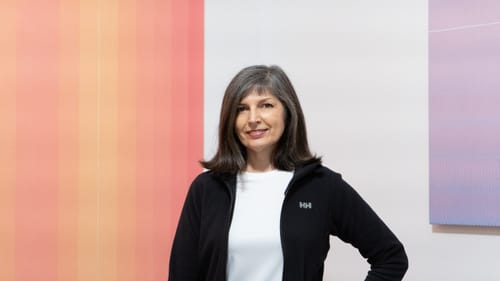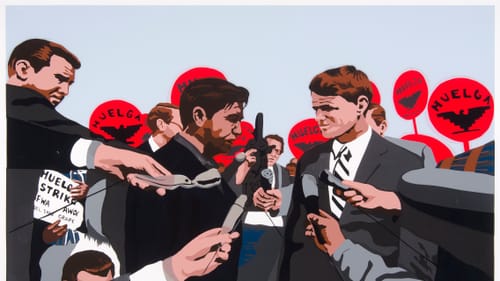Stay in the Loop
BSR publishes on a weekly schedule, with an email newsletter every Wednesday and Thursday morning. There’s no paywall, and subscribing is always free.
One museum, two journeys
Delaware Art Museum presents Our Red Planet and Estampas de la Raza

Currently at Delaware Art Museum are two exhibitions (one large, one small) that take the viewer on two different journeys: one cultural, one internal.
Ukrainian-born artist Anna Bogatin Ott lives in Philadelphia, but she’s foremost a citizen of the world beyond and within. DelArt’s Our Red Planet: Anna Bogatin Ott runs through Sunday, July 16, 2023. The original impetus for Ott’s recent work was our place in the cosmos, particularly in relation to NASA’s Mars exploration, wondering if the fourth planet from the sun actually “belongs” to us. But with the war in Ukraine, the title of the exhibition took on a different meaning, feeling that “our planet is bleeding red.” Ott’s 18 works on view, many of them new, invite introspection and contemplation.
Subtlety and “slow looking”
Curated by Margaret Winslow, the show has pieces (large and small) that often appear one-dimensional, but their subtlety invites the practice of “slow looking.” The four small panels of Glorious Truth, Part 2 (2022) seem like solid color blocks, but their gold paint is spread on newsprint from New York, Philadelphia, and Delaware newspapers. A larger companion piece, the four-foot-long Glorious Truth, Part 1 (2022), is hung to be viewed from the back, showing the artist’s hand as light filters through the tracing paper.
There are three colored-pencil drawings—the Hope series (2005)—whose imprint on the paper is barely perceptible, and at the exhibition entrance are eight 12-inch-square archival pigment prints on aluminum (2019-2021), three titled Moon and five titled Mars, composed of delicate, captivating, sometimes-oscillating horizontal lines. The exhibition’s largest work, the five-by-10-foot acrylic-on-canvas diptych Mars Wandering (2022), seems composed of simple red paint swatches until you are close enough to see its glittering surface.

Contiguity (2022), red wine on tracing paper, has overlapping panels whose installation makes you want to peer behind to see the structure of this piece. Trying to do so, I was gently (and rightly) admonished by a recorded voice to “move away from the artwork,” the first time I’ve experienced this. Conversely, Path to the Light (2022) is a large painted floorcloth with a labyrinth that encourages us to walk on it. Spending time in this exhibition—more than I anticipated—raised questions both personal and artistic, surely the aim of this intriguing artist.
A vibrant cultural sphere
Estampas de la Raza: Contemporary Prints from the Romo Collection, on view at DelArt through Sunday, May 28, 2023, is a colorful exhibition of impeccably created and widely varied screen prints that immediately draw you into their vibrant cultural sphere. Curated by Heather Campbell Coyle, the show begins in the museum’s orientation hallway, where noted Mexican-born Philadelphia muralist Cesar Viveros was commissioned to recreate a bodega, the ubiquitous urban gathering place at once commercial, communal, and cultural. Screen prints were commonly posted in bodegas to advertise social events, political marches, and popular activities, and Viveros began his career making such signs for shops and events.
His engaging mural provides the perfect entrée into Estampas de la Raza, an exhibition of 61 works from 44 artists. It chronicles the heritage, history, and experience of Mexican Americans and Latinos (1980 to 2010) in screen prints and lithographs drawn from the collection of the McNay Art Museum in San Antonio, Texas.
These works were collected by Harriett and Ricardo Romo (lifelong educators) who spent four decades supporting Latino artists. Inspired by the Chicano art movement of the 1960s and 1970s, the printmakers explore icons like Frida Kahlo and Che Guevara, as well as celebrating cultural traditions. Most works were created in three important print shops: Self Help Graphics & Art and Modern Multiples (both in Los Angeles), and Coronado Studio (Austin, Texas), institutions central to the creativity and cultural awareness of their communities.
Politics and rites of passage
The exhibition is organized around five themes: Identity; Struggle; Tradition, Culture, Memory; Icons; and Other Voices. The engaging tone is set immediately with the first large print you see, one of the most arresting in an exhibition filled with eye-catching works: El Pachuco (2002) by Ignacio Gomez. This gorgeous print abounds with textures and colors, including elegant sartorial drapery most often found only in paintings. Throughout, the print studios are acknowledged in wall text, and El Pachuco is a tribute to both the artist and the shop where it was pulled.
As you might expect, works vary with the inspirations of these artists. Veterano (1995) by Lawrence Colación engages the viewer with a direct gaze most often found in portraiture. Sonia Romero’s 2010 Bee Pile (Found ’em) is a commentary on an endangered species. Young Frida (Pink) (2006), a portrait of Frida Kahlo by Raul Caracoza, is the exhibition’s striking signature image.

Many prints are overt, strong political commentaries that engage the viewer with force or unexpected humor. Mickey Meurto (2005) by Artemio Rodríguez shows a fearsome Mickey Mouse, while Carlos Francisco Jackson’s Heulga (2009) depicts a meeting of two political luminaries: Robert Kennedy and Cesar Chavez. Works with cultural references include El Luchador (2009) by Jesus Barraza, showing one of the famed masked Mexican wrestlers, and the beautiful Stepping into the Light – Quinceañera (2008) by Ángel Rodríguez-Díaz, a heartfelt portrait of that important rite of passage.
Unchanging and intricate
The exhibition also includes a short film that illustrates the low-tech, unchanged, but nonetheless intricate, silkscreen process (utilizing multiple carefully planned “pulls”) by which these beautiful prints were created. And it features a second commission—by Julie Zavala, a graduate of the Art Institute of Philadelphia and Delaware fashion designer—who created an exhibition-inspired collection and a special piece on view: La Mera Mera, a mannequin wearing an outfit that references both the Virgin of Guadalupe and contemporary Latino culture. On Monday, May 13, the museum showcases the Zavala designs produced during her DelArt residency.
Exiting the museum, you’re back at Viveros’s mural, where opening-night crowds were clustered around this evocative work, gathering just as they would at a real bodega to discuss issues and people—and this beautiful, thought-provoking exhibition.
Above: Raul Caracoza’s 2006 screen print Young Frida (Pink). Collection of the McNay Art Museum; gift of Harriet and Ricardo Romo. Copyright Raul Caracoza. (Image courtesy of Delaware Art Museum.)
What, When, Where
Estampas de la Raza: Contemporary Prints from the Romo Collection, through May 28, 2023. Our Red Planet: Anna Bogatin Ott, through July 16, 2023. Delaware Art Museum, 2301 Kentmere Parkway, Wilmington. $14 ($7 for students, $6 for youth aged 7-18, free for youth under age 6). (302) 571-9590 or delart.org.
Accessibility
Delaware Art Museum and Copeland Sculpture Garden are wheelchair-accessible with free parking and a barrier-free entrance. Wheelchairs are available; personal-care attendants are admitted free.
Sign up for our newsletter
All of the week's new articles, all in one place. Sign up for the free weekly BSR newsletters, and don't miss a conversation.
 Gail Obenreder
Gail Obenreder